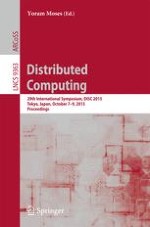2015 | OriginalPaper | Chapter
Limit Behavior of the Multi-agent Rotor-Router System
Authors : Jérémie Chalopin, Shantanu Das, Paweł Gawrychowski, Adrian Kosowski, Arnaud Labourel, Przemysław Uznański
Published in: Distributed Computing
Publisher: Springer Berlin Heidelberg
Activate our intelligent search to find suitable subject content or patents.
Select sections of text to find matching patents with Artificial Intelligence. powered by
Select sections of text to find additional relevant content using AI-assisted search. powered by
The
rotor-router
model, also called the
Propp machine
, was introduced as a deterministic alternative to the random walk. In this model, a group of identical tokens are initially placed at nodes of the graph. Each node maintains a cyclic ordering of the outgoing arcs, and during consecutive turns the tokens are propagated along arcs chosen according to this ordering in round-robin fashion. The behavior of the model is fully deterministic. Yanovski
et al.
(2003) proved that a single rotor-router walk on any graph with
m
edges and diameter
D
stabilizes to a traversal of an Eulerian circuit on the set of all 2
m
directed arcs on the edge set of the graph, and that such periodic behaviour of the system is achieved after an initial transient phase of at most 2
mD
steps. The case of multiple parallel rotor-routers was studied experimentally, leading Yanovski
et
al
. to the experimental observation that a system of
k
> 1 parallel walks also stabilizes with a period of length at most 2
m
steps. In this work we disprove this observation, showing that the period of parallel rotor-router walks can in fact, be superpolynomial in the size of graph. On the positive side, we provide a characterization of the periodic behavior of parallel router walks, in terms of a structural property of stable states called a
subcycle
decomposition
. This property provides us the tools to efficiently detect whether a given system configuration corresponds to the transient or to the limit behavior of the system. Moreover, we provide polynomial upper bounds of
$\mathcal{O}(m^{4}D^{2}$
+
mD
log
k
) and
$\mathcal{O}(m^{5}k^{2)}$
on the number of steps it takes for the system to stabilize. Thus, we are able to predict any future behavior of the system using an algorithm that takes polynomial time and space. In addition, we show that there exists a separation between the stabilization time of the singlewalk and multiple-walk rotor-router systems, and that for some graphs the latter can be asymptotically larger even for the case of
k
= 2 walks.
